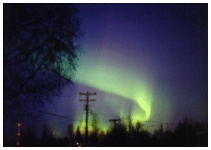
 Let's Harness that Power! By studying the Northern Lights or "auroras", scientists can learn more about the solar wind, how it affects the Earth's atmosphere, and how the energy might be used for useful purposes. The solar wind commonly generates billions of watts of electrical power in an auroral display. This can interfere with power lines, radio and television broadcasts, and satellite communications. Polar-orbiting satellites can measure this electrical power, and a range from 4-900 billion watts of power has been recorded in the northern hemisphere alone. Double that for total world production as nearly identical aurora are occuring in the southern hemisphere. Although this represents a huge amount of power, there is presently no known way to use this energy because it is spread over such a vast area. The actual power of a 1,000 billion watt storm might come down to less than a watt per 25 sq. feet / 65 sq. km. - not much compared to solar energy. One scientist has compared using solar power to trying to harness the mechanical energy of a swarm of mosquitoes!
Click pictures for more information and credits. Northern Lights SLIDE SHOW Today's Auroral Activity
Library:
Arctic,
Northern Lights |

|
DICTIONARY: Just "double-click" any unlinked word on this page for the definition from Merriam-Webster's Student Electronic Dictionary at Word Central. |

|
ARCTIC LIBRARY & GLOSSARY: Check this section for an index of the rest of the things you really need to know about the Arctic. |

|
ARCTIC MAPS & WEATHER REPORTS: Maps of the Northwest Passage, explorers' routes, iceberg sources, Nunavut, the Arctic by treeline, temperature... |

|
ARCTIC LINKS: Even more information! Links to sites related to the Arctic and "Iceberg: the Story of the Throps and the Squallhoots". |

|
GUIDE TO ARCTIC SUNRISE & SUNSET: How much sunlight or darkness is there in the Arctic on each day of the year? |
to is the property of their respective owners, and Athropolis is not responsible for their content.